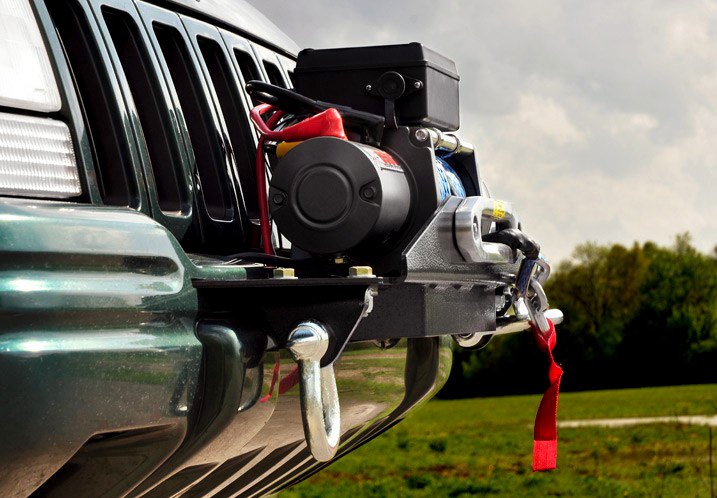Trailer hitches, properly called receiver hitches, are all the rage in our truck-obsessed society. When over 50% of the new vehicle purchases in the USA today are some kind of pickup truck, SUV, or minivan, the addition of a hitch at the rear of the vehicle makes perfect sense. Depending on the vehicle, a properly installed and rated rear hitch can pull up to 18,000 pounds. There certainly are enough people engaged in their hobbies of horse trailering, boating, or camping to make use of a truck and hitch. By the way, they are called "receiver hitches" because they accept, or receive, a ball mount and hitch ball which slide into the assembly. That ball mount can be conveniently removed and stowed when not in use.

What you may not have considered up until now is how useful and functional a front receiver hitch would be. Yes, front, as in, the front of your truck. Before you scoff, read on. A front mounted hitch can double your pleasure, providing a location to mount a bike carrier, winch, plow, or step plate. It could also allow you to (temporarily) maneuver a trailer into place with better visibility.
We offer a wide variety of front-mounted receiver hitches on our website. Let us clarify at this early stage that the hitches we carry, from the world's most reputable hitch manufacturers, are limited to being compatible with Sport Utility Vehicles (including crossovers), pickup trucks, and similar multi-purpose vehicles. You are not going to find front-mounted hitches for your sport sedan or convertible, for some very obvious reasons which we will explain as we go on.
Let's continue by looking at four different scenarios, with four different vehicles. We have a solution for each customer that results in the use of a front-mounted receiver hitch.
Customer #1
Chuck R. is very happy with his 2010 Buick Enclave, with which he and his family go on vacation every year. They use the rear-mounted trailer hitch to pull a small pop-up camper, but this year, with his two children getting bigger, they have been clamoring to bring the bicycles on vacation too. Chuck has seen all kinds of bike carriers for sale: roof-mounted, hitch-mounted, and so on. The roof mounted ones won't work for him because he already has a cargo box up there; and while the hitch-mounted ones look great (no need to lift the bikes very high off the ground), they all like camping so much that leaving the trailer at home just isn’t an option.

Then, Chuck discovers that Curt, one of the premier hitch manufacturers, makes a front trailer hitch for his Enclave. During his research, Chuck finds that this hitch can be mounted without drilling, and requires only simple hand tools which he already owns. He makes the purchase, installs the front hitch himself, and also purchases a hitch-mounted bike carrier.
Now, he can still pull the pop-up camper behind the Enclave, keep the cargo box on the roof, and comfortably carry both kids' bikes in the front. It's important to point out that the Enclave, as an SUV, sits higher off the ground than passenger cars. Safety is paramount, and Larry makes sure that the front-mounted bikes do not at all interfere with the driver's forward visibility. The great news is that the family can go on vacation and bring everything they need with them, leaving lots of room inside the truck for their own comfort.
Customer #2
Jeff L. loves his 2004 Dodge Dakota pickup truck. He bought it new, and since this model is no longer produced, he plans to hold onto it as long as possible. Jeff has always been a boater, and the Dakota's rear mounted hitch has been put to great use every summer during boating season.
However, as Jeff gets older, he finds that maneuvering the boat from the driver's seat is becoming a greater and greater challenge. More than once, he has jackknifed the trailer when backing up, and he used to pride himself on his ability to drive in reverse with a trailer in tow. He finds himself becoming increasingly concerned about missing the boat ramp the next time he's putting the boat into the water.

One evening Jeff discovers that Draw-Tite (same brand as his rear hitch) manufactures a front hitch specifically for his truck. He immediately notes that the receiver tube opening is 2" (same as the ball mount he already owns), and that no drilling is required for installation.
Jeff recognizes that a front-mounted hitch on his Dakota will allow him to both put his boat in the water and pull it out of the water, while looking out his windshield! We should point out that the Dakota, as a traditional body-on-frame vehicle, has the strength to both pull and push a boat and trailer combo. He's ecstatic with his Draw-Tite purchase. With the increased flexibility gained from a front-mount along with a rear-mount hitch, Jeff plans on holding onto the Dakota even longer than originally intended.
Customer #3
Jim W. recently purchased a pre-owned 2002 Jeep Grand Cherokee, specifically as a vehicle in which to go off-roading. He likes the fact that this truck can do double-duty as a daily driver and weekend warrior. Jim also knows that as his off-roading prowess improves, a winch is one of the first accessories in which he should invest. If he is rock-scrambling with friends, there will be someone to bail him out of a tough spot. However, if he’s alone and gets stuck, a winch can make the difference between getting back to paved roads or not. Jim's issue is that since he drives his Jeep every day of the week in all kinds of weather, he doesn't want the front-mounted winch to be permanently mounted.

Jim is looking at the Warn brand line of winches when he discovers that Warn also makes a front-mounted trailer hitch specifically for his Jeep. He then finds the Warn 9000 lb. Multi-Mount Electric Winch Kit. The beauty of this kit is that the winch is mounted on a carrier designed to fit into a 2" receiver hitch, the same size as the Warn front hitch.
This set-up means that when Jim wants the winch, he slides it into the receiver and goes out to have his fun. When he's commuting (or attending a star-studded Hollywood premiere), the winch can be removed and stored in his garage. Jim's Jeep, of course, as an all-wheel-drive vehicle, is specifically designed to be able to handle the rugged off-roading that he plans to subject it to, and likewise, the winch and front carrier together are designed to pull a vehicle like this out of danger without damaging the Jeep.
Customer #4
Charles F. has a brand new Jeep Wrangler (his first 4x4) that he plans to enjoy and get use out of for many miles. Now he’ll finally be able to climb his long steep driveway with ease in the winter – allowing him to park inside the garage when it snows instead of outside close to the street. And to further make his life easier during such occasions, Charles plans to hook a snow plow attachment up to his Jeep to make easy work of clearing the driveway.

When Charles called CARiD, he became aware of the SnowSport Plow Front Hitch with 2” Receiver that would allow him to mount a fitted snow plow attachment to it. Since this plow does not feature hydraulic power operation, its lower cost keeps it in reach of Charles’ budget, and it suits his needs which are limited to keeping his own driveway cleared. And, of course, Charles could use his SnowSport front hitch for any other of the applications mentioned in this article should he choose to.

We've now seen four different customers, with four different vehicles, each needing a solution for their personal transportation needs. In each case, a front-mounted receiver hitch provides the answer, whether it's to carry extra cargo, aid in maneuvering a trailer, leverage a winch as a rescue device, or use a basic snow plow attachment. Of course, front mounted hitches are for truck-type vehicles that are capable of maximizing their benefits.
If you own a pickup or SUV, expand your thinking beyond the "rear mounted" trailer hitch. A front trailer hitch could be the answer you've been searching for when it comes to increasing your vehicle's versatility.

